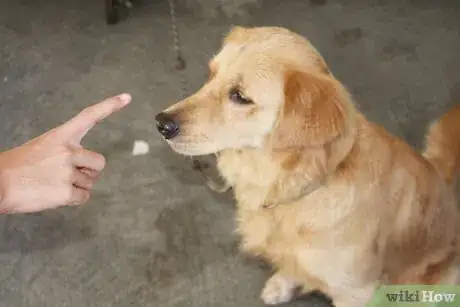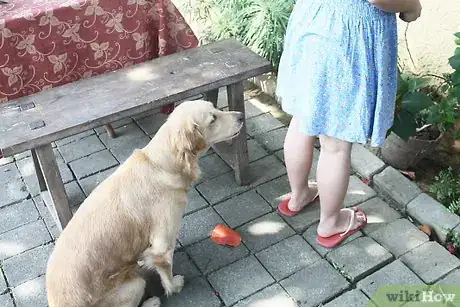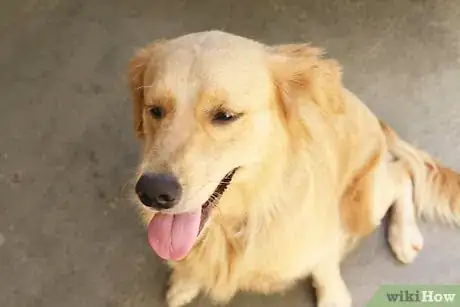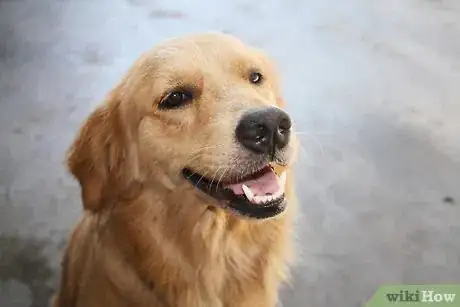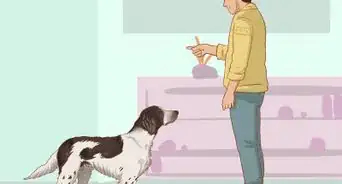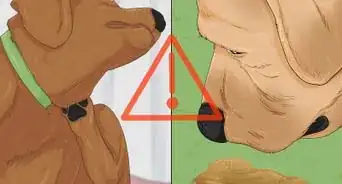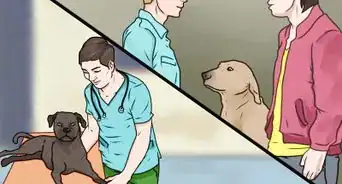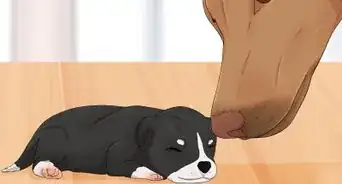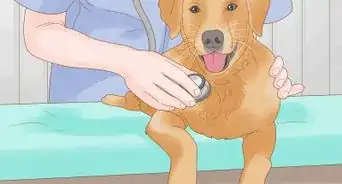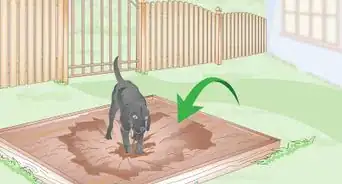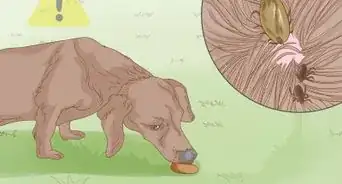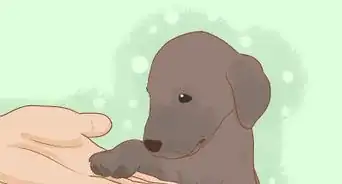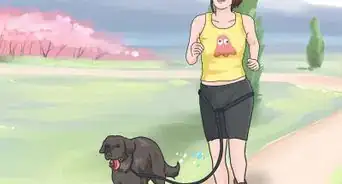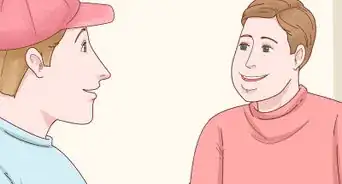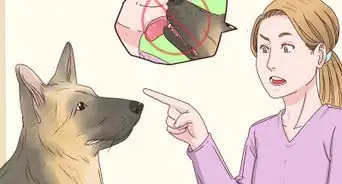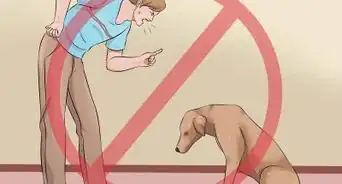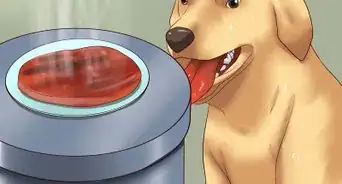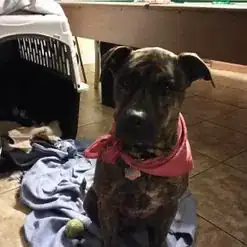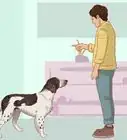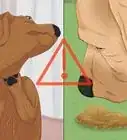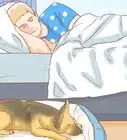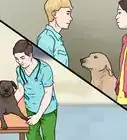This article was co-authored by Sheri Williams. Sheri Williams is a Certified Dog Trainer and Behaviorist and the Owner of sheriwilliams.com, a business that specializes in teaching veterans how to turn their dogs into service dogs or emotional support animals to assist with PTSD. Based in the Los Angeles, California metro area, Sheri has over 20 years of dog training experience and also runs a general dog training practice specializing in rehabilitating dogs through positive reinforcement training techniques. She is certified by The Animal Behavior and Training Association.
wikiHow marks an article as reader-approved once it receives enough positive feedback. In this case, 85% of readers who voted found the article helpful, earning it our reader-approved status.
This article has been viewed 454,472 times.
Nobody likes to have a handful of groceries knocked out of their hand or get muddy paw prints on their new pants as they walk through their own front door, let alone someone else's front door. Jumping up can be a cute greeting when you have a small puppy or dog at home, but as time goes on, it can become quite annoying to you and your guests. Teaching your dog to calmly greet you and your guests, without jumping, will create a much more enjoyable environment to enter into after a long day at work or when receiving guests at home.
Steps
Using Aversion Training
-
1Understand the dog's behavior. In a dog's world, it is instinctual to greet another dog by coming nose-to-nose with them. This allows them to sniff each other's faces and become acquainted with the other dog's scent. Of course, your nose is a bit higher to reach so it is only natural that your dog will jump up to get closer to your face when greeting you.[1] This can be quite annoying and unnecessary, but fortunately, the habit can be broken.
-
2Start discouraging the behavior early. You may think it is sweet when your dog greets you by jumping on you. For the most part, puppies think that when they jump up on someone, they are highly likely to be picked up and cuddled soon after.
- It is best to start discouraging this type of greeting behavior as early as possible. You will be excited to see your puppy as well, but if your puppy has this tendency, you can do this by practicing the no touch, no talk, no eye contact rule when greeting your puppy.
- Avoid looking or talking to your puppy until she settles down. This, in turn, will send out calming signals to her and will avoid getting her excited or anxious about your arrival.
- Puppies tend to learn very quickly, so it will be much easier to train her to greet you in a calm and desirable manner the younger she is.
- Although it isn't an issue when she is little, you may be encouraging a bad habit that could be difficult to break later when she becomes an adult. A small, 15 pound Labrador puppy jumping up on you is quite a different story than a full-grown 100 pound Labrador that could knock you over and even injure you or your guests.
Advertisement -
3Ignore her when she jumps up. One way to teach your dog, no matter her age, that jumping up is not an acceptable greeting is to ignore her during this behavior. This involves turning your back to her and not giving her any type of attention, such as physical, vocal, or eye contact.
- As soon as your dog is calm and all four paws are on the ground, tell her she is being a good girl and give her a small treat or loving pat on the head.
- Try to talk in a calm voice and use calm petting techniques to avoid your dog becoming too excited again. If she returns to her jumping behavior, turn your back again and ignore her.
- In the early stages of this training, you may be turning in circles several times, but your dog will soon relate her jumping to your lack of attention and stop.
- As with any training, consistency is key. This means that everyone in the household and all guests should be informed that training is in progress and be willing participants.[2] Even the occasional attention given to your dog while she is jumping can encourage her and could result in several steps backwards in your training process.[3]
Using Additional Training Methods
-
1Redirect with a sit command. The simple 'sit' command can be useful in many different situations. Most importantly, it is a great distraction technique for redirecting your dog's attention from an undesirable behavior, such as jumping up. When your dog jumps up on you, turn your back to them while keeping them in your peripheral vision. Ask her to sit and immediately praise her when she does so.
- If your dog is too excited to notice that you are asking her to sit, ignore her excited behavior until she calms down, and then repeat the command. Again, as soon as she follows your command, give her lots of praise or a special treat to let her know this is the behavior that gets rewarded, not jumping.
- With this simple command, the goal is to redirect your dog's jumping behavior with a task that should be easy to perform and then rewarded well. Your dog will soon figure out which greetings get her your full attention and which don't.
- If your dog doesn't know the sit command yet, start teaching her the command along and then try this method.[4]
-
2Use a special toy. Some dogs exude such extreme excitement when greeting someone that it may be difficult and time consuming to wait for them to calm down for a redirecting sit command. If this sounds like your dog, she may be more inclined to grab a toy and shake it or hold it instead.
- Keep a special toy by your front door to throw for your dog or give to her when you come home. This will redirect her energy into playing with the toy as opposed to jumping on you or your guests.[5]
-
3Stay calm. The key to keeping your dog calm, and therefore exhibit calm behavior, is to also participate in only calm behavior when you come home. Try not to use a high-pitched or loud voice when talking to her. This includes shouting at her when she starts jumping up. This type of vocal tone could encourage more excitement and jumping.
- Instead of using physical punishment to discourage bad behavior, teach your dog what behaviors get them the most rewards from you. You will have to repeat the actions of her training multiple times before she will get it.
- Don't get frustrated or upset because this will make her worse. Keep at it and she will eventually catch on
Expert Q&A
-
QuestionWhat does it mean when a dog jumps up?
 Sheri WilliamsSheri Williams is a Certified Dog Trainer and Behaviorist and the Owner of sheriwilliams.com, a business that specializes in teaching veterans how to turn their dogs into service dogs or emotional support animals to assist with PTSD. Based in the Los Angeles, California metro area, Sheri has over 20 years of dog training experience and also runs a general dog training practice specializing in rehabilitating dogs through positive reinforcement training techniques. She is certified by The Animal Behavior and Training Association.
Sheri WilliamsSheri Williams is a Certified Dog Trainer and Behaviorist and the Owner of sheriwilliams.com, a business that specializes in teaching veterans how to turn their dogs into service dogs or emotional support animals to assist with PTSD. Based in the Los Angeles, California metro area, Sheri has over 20 years of dog training experience and also runs a general dog training practice specializing in rehabilitating dogs through positive reinforcement training techniques. She is certified by The Animal Behavior and Training Association.
Certified Dog Trainer People often really confuse this behavior. Sometimes it is genuine joy, but most dogs who jump up on people aren't just trying to be friendly. Dogs wiggle, wag their tail, and fidget a bit when they're happy. Many dogs are trying to claim you when they jump up. They're putting their scent on you and they're trying to establish control.
People often really confuse this behavior. Sometimes it is genuine joy, but most dogs who jump up on people aren't just trying to be friendly. Dogs wiggle, wag their tail, and fidget a bit when they're happy. Many dogs are trying to claim you when they jump up. They're putting their scent on you and they're trying to establish control. -
QuestionWhat if my dog doesn't listen when I back up?
 Sheri WilliamsSheri Williams is a Certified Dog Trainer and Behaviorist and the Owner of sheriwilliams.com, a business that specializes in teaching veterans how to turn their dogs into service dogs or emotional support animals to assist with PTSD. Based in the Los Angeles, California metro area, Sheri has over 20 years of dog training experience and also runs a general dog training practice specializing in rehabilitating dogs through positive reinforcement training techniques. She is certified by The Animal Behavior and Training Association.
Sheri WilliamsSheri Williams is a Certified Dog Trainer and Behaviorist and the Owner of sheriwilliams.com, a business that specializes in teaching veterans how to turn their dogs into service dogs or emotional support animals to assist with PTSD. Based in the Los Angeles, California metro area, Sheri has over 20 years of dog training experience and also runs a general dog training practice specializing in rehabilitating dogs through positive reinforcement training techniques. She is certified by The Animal Behavior and Training Association.
Certified Dog Trainer You hear this suggestion regularly; just step back so the dog falls and they'll eventually stop. This rarely works. I recommend pushing your chest out a little bit, look them in the eye emotionlessly, and say "off." Be consistent, don't let them move you, and never back up!
You hear this suggestion regularly; just step back so the dog falls and they'll eventually stop. This rarely works. I recommend pushing your chest out a little bit, look them in the eye emotionlessly, and say "off." Be consistent, don't let them move you, and never back up! -
QuestionHow do you train your dog not to jump up on people?
 Pippa Elliott, MRCVSDr. Elliott, BVMS, MRCVS is a veterinarian with over 30 years of experience in veterinary surgery and companion animal practice. She graduated from the University of Glasgow in 1987 with a degree in veterinary medicine and surgery. She has worked at the same animal clinic in her hometown for over 20 years.
Pippa Elliott, MRCVSDr. Elliott, BVMS, MRCVS is a veterinarian with over 30 years of experience in veterinary surgery and companion animal practice. She graduated from the University of Glasgow in 1987 with a degree in veterinary medicine and surgery. She has worked at the same animal clinic in her hometown for over 20 years.
Veterinarian Teach your dog to sit on a particular spot (such as a mat) when you expect visitors. Alternatively, keep a leash on the dog in the house, and when the dog goes to jump up, tread on the leash.
Teach your dog to sit on a particular spot (such as a mat) when you expect visitors. Alternatively, keep a leash on the dog in the house, and when the dog goes to jump up, tread on the leash.
References
- ↑ http://www.humanesociety.org/animals/dogs/tips/jumping_up.html
- ↑ Sheri Williams. Certified Dog Trainer. Expert Interview. 5 June 2020.
- ↑ https://www.vetbabble.com/dogs/questions-dogs/stop-dog-jumping-guests/
- ↑ https://www.aspca.org/pet-care/virtual-pet-behaviorist/dog-behavior/teaching-your-dog-not-jump-people
- ↑ https://www.aspca.org/pet-care/virtual-pet-behaviorist/dog-behavior/teaching-your-dog-not-jump-people
- ↑ https://www.aspca.org/pet-care/virtual-pet-behaviorist/dog-behavior/teaching-your-dog-not-jump-people
About This Article
To stop a dog from jumping, start discouraging the behavior as early as possible. When your dog jumps, turn your back and avoid physical, vocal, or eye contact until the dog stops jumping. As soon as your dog is calm and has all 4 paws on the ground, give vocal praise and a tasty treat to reinforce the behavior. Talk in a soothing voice and use calm petting techniques to prevent exciting your dog again. Be consistent with your training to get lasting results! For tips on reinforcing your training with verbal commands, read on!

